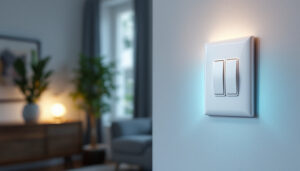

In the ever-evolving world of lighting design, track lighting has emerged as a popular choice for both residential and commercial applications. Its versatility and adaptability make it a go-to solution for many lighting contractors. This article aims to provide essential insights into track lighting systems, helping contractors to enhance their understanding and implementation of these systems in various projects.
Track lighting consists of a series of fixtures mounted on a track that can be adjusted to illuminate specific areas. This flexibility allows for a wide range of applications, from highlighting artwork in galleries to providing ambient lighting in restaurants. Understanding the components and functionality of track lighting is crucial for any lighting contractor.
The primary components of track lighting include the track itself, the fixtures, and the power supply. The track is usually made of metal and serves as the backbone of the system, allowing for easy installation and reconfiguration of fixtures. Fixtures can vary in design, from spotlights to pendants, providing options for different lighting effects. Additionally, many modern fixtures come equipped with LED technology, which not only enhances energy efficiency but also offers a longer lifespan compared to traditional bulbs. This advancement in lighting technology has made track lighting an increasingly popular choice among environmentally conscious consumers.
Power supplies are essential for track lighting systems, as they provide the necessary electricity to the fixtures. Depending on the design, contractors may choose between low-voltage and line-voltage systems, each offering distinct advantages and challenges. Line-voltage systems are often favored for their straightforward installation process, while low-voltage systems can provide more intricate lighting designs due to their smaller fixtures and greater versatility. Furthermore, low-voltage systems can also contribute to reduced energy costs over time, making them an attractive option for both residential and commercial projects.
There are primarily two types of track lighting systems: line-voltage and low-voltage. Line-voltage systems operate at 120 volts and are commonly used in residential settings. They are easier to install since they do not require a transformer, making them a popular choice for many contractors. The simplicity of line-voltage systems allows homeowners to easily adjust their lighting configurations as their needs change, whether they are hosting a dinner party or simply enjoying a quiet evening at home.
Low-voltage systems, on the other hand, operate at 12 or 24 volts and typically require a transformer. These systems are often used in commercial applications where energy efficiency and design flexibility are paramount. The ability to create a layered lighting effect with low-voltage systems can enhance the overall ambiance of a space, making it feel more inviting and dynamic. Moreover, low-voltage track lighting can be particularly effective in retail environments, where it can be used to draw attention to specific products or displays, thereby influencing customer behavior and enhancing the shopping experience. Understanding the differences between these systems is crucial for contractors when selecting the appropriate type for a project.
Track lighting offers numerous advantages that make it an attractive option for contractors. Its flexibility, ease of installation, and aesthetic appeal contribute to its popularity. By understanding these benefits, contractors can better communicate the value of track lighting to their clients.
One of the most significant advantages of track lighting is its design flexibility. The ability to reposition fixtures along the track allows for customization according to the specific needs of a space. This adaptability is particularly beneficial in environments where lighting needs may change frequently, such as retail stores or galleries.
Contractors can also mix and match different fixture styles and types on the same track, allowing for creative and dynamic lighting solutions. This flexibility not only enhances the visual appeal of a space but also allows for functional lighting that meets the requirements of various activities. For instance, in a gallery setting, track lighting can be adjusted to spotlight individual artworks, creating an engaging experience for visitors. Similarly, in a home environment, track lighting can be configured to highlight architectural features or create ambient lighting for gatherings, showcasing the versatility of this lighting solution.
Track lighting systems are generally straightforward to install, making them a preferred choice for many contractors. The modular nature of track lighting allows for quick setup and adjustments, which can save time and labor costs on projects. Additionally, many manufacturers provide comprehensive installation guides, further simplifying the process.
Moreover, the ability to easily add or remove fixtures without extensive rewiring is a significant advantage. This feature allows contractors to accommodate changes in design or client preferences without incurring additional costs or delays. Furthermore, track lighting can be installed in various configurations, whether it be a straight line, a curved path, or even in a zigzag pattern, allowing contractors to creatively adapt to the unique dimensions and characteristics of each space. This adaptability not only enhances the contractor’s ability to meet client expectations but also opens up opportunities for innovative designs that can elevate the overall aesthetic of the project.
Selecting the appropriate track lighting system involves considering various factors, including the intended use of the space, the desired aesthetic, and the budget. By evaluating these elements, contractors can make informed decisions that align with client expectations and project requirements.
Before choosing a track lighting system, it is essential to assess the space where it will be installed. Factors such as ceiling height, room dimensions, and existing architectural features can influence the effectiveness of the lighting solution. For instance, higher ceilings may require more powerful fixtures or additional tracks to ensure adequate illumination.
Additionally, understanding the primary functions of the space will help determine the type of lighting needed. For example, a gallery may require focused lighting to highlight artwork, while a restaurant may benefit from softer, ambient lighting to create a welcoming atmosphere.
Budget constraints are a common consideration for many projects. Track lighting systems can vary significantly in cost, depending on the quality of materials, fixtures, and installation complexity. Contractors should work closely with clients to establish a realistic budget that balances quality and affordability.
It is also wise to consider the long-term costs associated with energy efficiency and maintenance. Investing in higher-quality fixtures may result in lower energy consumption and reduced replacement costs over time, ultimately benefiting the client’s bottom line.
Proper installation is critical to the performance and longevity of track lighting systems. Adhering to best practices ensures that the system operates efficiently and safely. Lighting contractors should be well-versed in these practices to deliver high-quality installations.
Safety is paramount when installing track lighting. Contractors should always adhere to local electrical codes and regulations. This includes ensuring that the track is securely mounted and that all wiring is properly insulated and connected. Utilizing appropriate safety gear and tools during installation can prevent accidents and injuries.
Additionally, it is essential to verify that the electrical supply is turned off before beginning any installation work. This precaution not only protects the contractor but also ensures the safety of the property and its occupants.
After installation, testing the track lighting system is crucial to ensure that all fixtures function correctly. This includes checking for proper alignment, verifying that all connections are secure, and ensuring that the lighting meets the intended design specifications. Conducting a thorough inspection can help identify any issues early on, allowing for timely corrections.
Furthermore, educating clients on how to operate and maintain the system can enhance their overall satisfaction. Providing clear instructions on adjusting fixtures or replacing bulbs can empower clients to make the most of their track lighting system.
As design trends evolve, so too do the styles and applications of track lighting. Staying informed about the latest trends can help contractors offer innovative solutions that meet client expectations. Here are some current trends shaping the track lighting landscape.
Minimalism continues to dominate design trends, and track lighting is no exception. Sleek, unobtrusive fixtures that blend seamlessly with the surrounding decor are increasingly popular. Contractors should consider offering options that align with this aesthetic, such as low-profile tracks and fixtures with clean lines.
These minimalist designs not only enhance the overall look of a space but also allow the lighting to take center stage without overwhelming the decor. This trend is particularly relevant in modern residential and commercial spaces where simplicity is key.
The integration of smart technology into track lighting systems is another trend gaining traction. Smart lighting solutions allow users to control their lighting through mobile apps or voice commands, offering convenience and energy efficiency. Contractors should familiarize themselves with these technologies to provide clients with cutting-edge options.
Incorporating smart features can also enhance the functionality of track lighting, allowing for customizable settings that cater to different activities or moods. This adaptability is particularly appealing to tech-savvy clients looking to modernize their spaces.
Track lighting represents a versatile and practical solution for various lighting needs. By understanding the components, advantages, and installation best practices associated with track lighting, contractors can enhance their service offerings and meet the diverse demands of their clients. Staying informed about current trends and technologies will further empower contractors to deliver innovative lighting solutions that stand out in a competitive market.
Ultimately, the key to success in track lighting installations lies in a combination of technical knowledge, creative design, and a commitment to quality. By embracing these principles, lighting contractors can elevate their projects and provide exceptional value to their clients.
Ready to take your track lighting installations to the next level? At LumenWholesale, we provide lighting contractors with the highest quality, spec-grade lighting products at prices that can’t be beaten. Say goodbye to local distributor markups and hello to our premium selection that meets rigorous industry standards. With free shipping on bulk orders, you can stock up on superior lighting solutions and enjoy the best value without any hidden costs. Elevate your lighting projects with the perfect combination of quality, affordability, and convenience. Wholesale Lighting at the Best Value is just a click away.

Discover essential tips and best practices for lighting contractors on installing and maintaining ceiling light fan switches.

Discover how LED outdoor flood lights can revolutionize your lighting installation projects with enhanced efficiency, durability, and energy savings.

Discover essential tips and common pitfalls for lighting contractors when installing pendant lighting.

Explore the fascinating history and modern resurgence of gas lighting in this insightful article tailored for lighting contractors.
Get notified when NEW deals are released.
Optimize your budget with wholesale discounts.
Only top-quality, specification-grade lighting products.
No additional costs at checkout - what you see is what you pay.
We understand the unique needs of contractors.